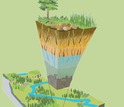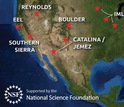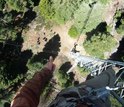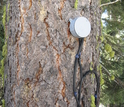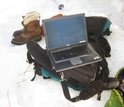News Release 14-155
NSF awards $1.35 million for new institute focused on Earth's critical zone: Where rock meets life
Institute scientists will cross the boundaries of Earth's critical zone from tree canopy to groundwater base
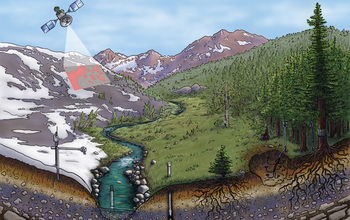
NSF has funded a new institute focused on Earth's critical zone: Where rock meets life.
November 21, 2014
This material is available primarily for archival purposes. Telephone numbers or other contact information may be out of date; please see current contact information at media contacts.
Find related stories on NSF's Critical Zone Observatories at this link.
Scientists at observatories across the United States who study Earth's thin but life-sustaining veneer are getting new resources to answer questions with global implications.
Supported by a $1.35 million grant from the National Science Foundation (NSF), researchers at 10 locations are working to improve understanding of Earth's critical zone.
The critical zone stretches from the tree canopy to deep groundwater. It's where rock, soil, water, air and living organisms interact to shape Earth's surface.
Research being done at the 10 NSF observatories, called Critical Zone Observatories (CZOs), is helping scientists forecast how Earth will react to changing climate and land use, important in a time when global population and demand for natural resources are expected to mushroom in coming decades.
To find those answers, scientists say, the CZOs need to develop networked sites.
That's the goal of the CZO Science Across Virtual Institutes (SAVI), created with support of the new NSF grant.
"The CZO SAVI will focus on building national and international partnerships with other environmental observatory programs and on developing common measurements to answer pressing scientific questions on regional and global scales," says Enriqueta Barrera, NSF CZO program director.
CZO SAVI scientists are addressing questions that pose major challenges to humanity's future and boosting collaborations among observatories and the larger Earth surface science community.
"We need to build a network if we'd like to answer scientific and socially relevant questions," adds Tim White, CZO national office coordinator and a geoscientist at Penn State. "We need to do science across the observatories."
That means designing experiments that can be conducted at the 10 CZO sites and their counterparts in Europe, China and Australia and training new scientists to carry out and continue the work.
"The CZO SAVI will promote interactions among scientists around the world working to understand how the surface Earth transforms over time," says Susan Brantley, a CZO scientist at Penn State. "We're measuring the rates of change in the past and relating those to rates today."
Adds Henry Gholz, program director in NSF's Division of Environmental Biology, which co-funded the CZO SAVI with NSF's Division of Earth Sciences, "This award will lead to the networking of environmental observations and research focused on the Earth's surface.
"Linking the CZO network with other environmental observatory networks, and with international counterparts, offers new opportunities to advance our understanding of ecosystems around the globe."
NSF's CZO Program started in 2007 with three observatories: the Susquehanna-Shale Hills Observatory in Pennsylvania; the Southern Sierra Observatory in California; and the Boulder Creek Observatory in Colorado.
The observatories brought together scientists from several fields and encouraged a new understanding of the physical, biological and chemical processes in the critical zone.
In 2009, three additional observatories were added: the Luquillo Mountains CZO in Puerto Rico; Christina River Basin CZO in Delaware and Pennsylvania; and Jemez River Basin/Santa Catalina Mountains CZO in Arizona and New Mexico.
Last year, four new CZOs joined the group: the Eel River CZO in northern California; Reynolds Creek CZO in Idaho; Intensively Managed Landscape CZO in Illinois, Iowa and Minnesota; and Calhoun Forest CZO in South Carolina.
Each observatory benefits from cross-disciplinary collaboration: experts working together from fields including hydrology, geochemistry, geomorphology, ecology and climatology.
"The challenge is: how do you get all these people doing different research--from different disciplines and in different parts of the country--thinking about the same science?" White asks.
Last year, the CZO National Office was created to help scientists at individual sites answer network-wide questions.
The CZO SAVI will take the collaboration the next step, providing funding to help researchers coordinate and conduct similar science experiments.
"That's the focus," White says. "How do we get the measurements to answer cross-site questions? SAVI provides funding for the training and meetings that requires.
"Five years down the road, we'd like to say that the observatories are making common measurements, addressing environmentally-relevant societal issues and beginning to move that information into the decision-making and policy realms."
-NSF-
-
In the critical zone, rock, soil, water, air and living organisms shape Earth's surface.
Credit and Larger Version -
NSF's network of Critical Zone Observatories stretches from coast to coast across North America.
Credit and Larger Version -
Research in the critical zone takes scientists from bedrock to the top of the tree canopy.
Credit and Larger Version -
Listening to the forest's heartbeat: A sap-flux meter monitors a tree in the critical zone.
Credit and Larger Version -
Science-in-the-snow: Downloading data from instruments placed on critical zone trees.
Credit and Larger Version
Media Contacts
Cheryl Dybas, NSF, (703) 292-7734, email: cdybas@nsf.gov
Matthew Carroll, Penn State, (703) 292-7734, email: mjc48@psu.edu
Related Websites
NSF Award: SAVI: Crossing the Boundaries of Critical Zone Science with a Virtual Institute: http://www.nsf.gov/awardsearch/showAward?AWD_ID=1445246&HistoricalAwards=false
NSF News: NSF awards grants for four new critical zone observatories to study Earth surface processes: http://www.nsf.gov/news/news_summ.jsp?cntn_id=130115
NSF CZO Discovery Article Series: http://nsf.gov/discoveries/disc_summ.jsp?cntn_id=130991
NSF Publication: Discoveries in the Critical Zone: http://www.nsf.gov/pubs/2013/nsf13112/nsf13112.pdf
NSF News: NSF Awards Grants for Three Critical Zone Observatories: http://www.nsf.gov/news/news_summ.jsp?cntn_id=110586
NSF News: Study Ties Forest "Greenness" in Western U.S. to Snowpack Extent: http://www.nsf.gov/news/news_summ.jsp?cntn_id=125359
NSF News: Iron Furnaces Leave Legacy: Soil High in Manganese: http://www.nsf.gov/news/news_summ.jsp?cntn_id=118209
The U.S. National Science Foundation propels the nation forward by advancing fundamental research in all fields of science and engineering. NSF supports research and people by providing facilities, instruments and funding to support their ingenuity and sustain the U.S. as a global leader in research and innovation. With a fiscal year 2023 budget of $9.5 billion, NSF funds reach all 50 states through grants to nearly 2,000 colleges, universities and institutions. Each year, NSF receives more than 40,000 competitive proposals and makes about 11,000 new awards. Those awards include support for cooperative research with industry, Arctic and Antarctic research and operations, and U.S. participation in international scientific efforts.
Connect with us online
NSF website: nsf.gov
NSF News: nsf.gov/news
For News Media: nsf.gov/news/newsroom
Statistics: nsf.gov/statistics/
Awards database: nsf.gov/awardsearch/
Follow us on social
Twitter: twitter.com/NSF
Facebook: facebook.com/US.NSF
Instagram: instagram.com/nsfgov



